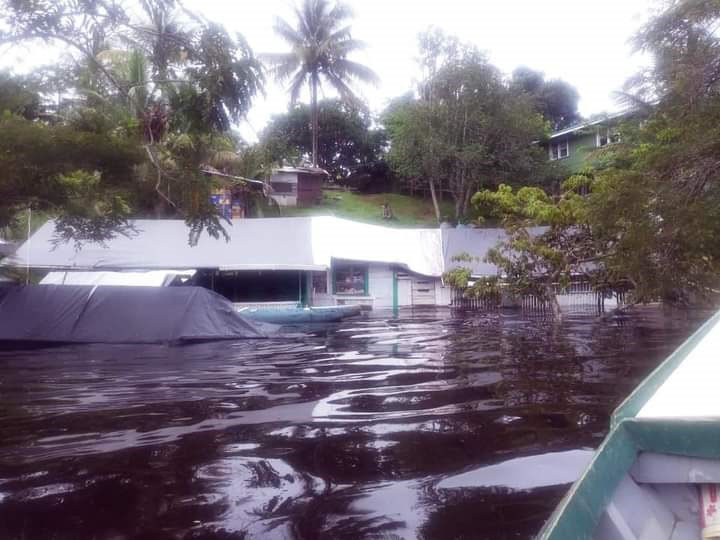Hundreds of flood-stricken residents in Region Seven have begun the long haul to recovery as floodwaters continue to recede.
The region has been devastated by widespread flooding brought on by torrential downpours, inundating indigenous communities and mining pits, as well as destroying farms.
Last week, Christine George stepped back inside her home in flood-hit Kamarang, an indigenous community located close to the Mazaruni River, to find mud-caked floors and gut-wrenching destruction.
The flash flood that claimed her house in the wee hours of the morning on June 2 had left her no time to save her precious belongings as she was forced to evacuate her home immediately with her seven-year-old child when she woke to waist-high floodwaters.
More than a month has passed since that fateful day but George has not spent more than a few hours in her home since the floodwaters began receding two weeks ago.
When she visited her home for the first-time since the flooding, she recalled feeling completely devastated and heartbroken. Everything in her home had been destroy-ed: clothes, electrical appliances, mattresses, books, along with hundreds of dollars’ worth in supplies that were in her shop. According to George, the walls of the house which are made of plywood sheets sustained major damage. “There was a lot of wood ants and the rats have destroyed all our clothes. Everything was completely destroyed,” she lamented.
George disclosed that like the rest of the families who were affected in the community, she has not yet moved back into her home, fearing that there might be another flood and also, because the stench left behind is overwhelming.
Seventeen families living along the banks of the Mazaruni River in the community were forced to evacuate. Some are currently living in churches and other public buildings in the community while others are being accommodated by their relatives.
“The area still all messed up and we are waiting for more sun to dry out the place then burn everything that was damaged. We are waiting to see how the weather would be and then maybe move in,” she said.
She noted that some families are planning to relocate to higher ground in fear of such a disaster repeating itself.
Currently, George said, she is trying to figure out a way to make money so that she can repair her home and shop but stated that many have begun the long road to recovery by cleaning their homes.
Meanwhile, Regional Vice Chairman Kamal Persaud confirmed that floodwaters have receded significantly in the area but noted that the recovery process will take some time even as hundreds across the regions are making efforts to settle back into their homes and finding ways to survive.
She said that most of the displaced are living in camps with tarpaulins and plywood sheets as walls, which makes it easier for some to relocate to higher ground while others with more permanent structures are trying to repair the damaged parts of their homes.
Despite their efforts, she said, there is urgent need for assistance as many do not have the tools that would assist with the relocation process. Farmers whose crops have been destroyed are feeling the biggest strain as their crops were their main source of income.
She pointed out however, the needs vary as farmers would need farming tools and seedlings to begin farming again, while miners have said they would need financial assistance, and tax exemptions and for loans or mortgages to be relaxed.
She noted that it has been two weeks since water has started to recede but almost everyone is pleading for assistance. “They are still pleading for help. Any form of help is very much needed and welcomed so that those persons and families can get back on their feet. The farmers lost everything so they are not capable of buying seedlings,” she said.
Persaud welcomed the assessment done by the international and regional bodies and expressed the hope that the government will follow through with the recommendations made by those bodies which includes financial assistance and relocation.
The Civil Defence Com-mission (CDC) has indicated to Stabroek News that they are yet to receive an official report from the teams that were conducting the assessment in the five flood-hit regions but they have continued to provide assistance to communities that are still affected by flooding and those that have started the recovery process.
Since May 18, the CDC reported that over 36,000 households from 300 communities countrywide have been affected by flooding. Guyana’s flooding has been classified as a Level 2 Disaster under the Caribbean Disaster Emergency Manage-ment Agency’s (CDEMA) regional response mechanism, but the CDC has said that five regions are classified even worse as the impact is varied.
A team comprising of representatives from the United Nations, UNICEF, CDEMA, CARPHA, and PAHO recently travelled to regions Two, Five, Six, Seven, and Ten to conduct preliminary detailed assessments of the flooding situation in these regions. “With that assessment, we will get an understanding of the damage and losses,” Director General of the CDC Lieutenant Colonel Kester Craig said.
Prime Minister Mark Phillips reported to the National Assembly that the rainfall recorded over the past month was the second highest in four decades. “Based on the latest seasonal reports, it is estimated that we will continue to experience above normal rainfall during the period June to August, 2021”, he said.






